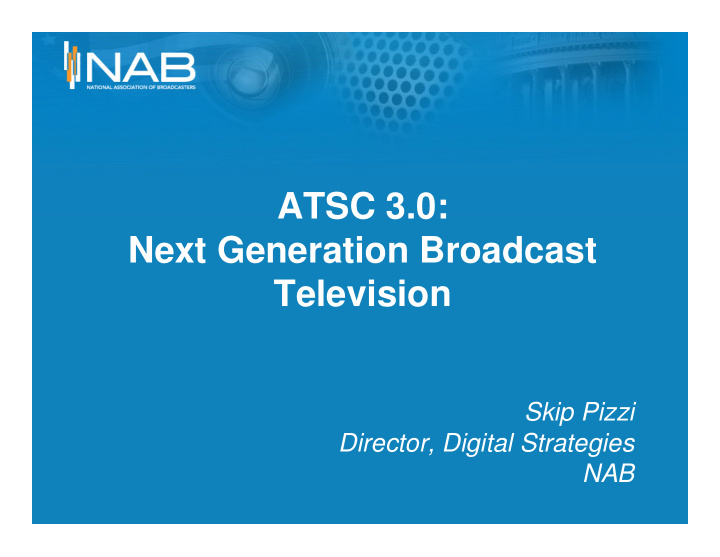



ATSC 3.0: Next Generation Broadcast Television Skip Pizzi Director, Digital Strategies NAB
ATSC 3.0: Process to date � Initially known as “ATSC Next Generation Broadcast Television” (NGBT) � Now also referred to as “ATSC 3.0” � First steps conducted by ATSC Planning Team 2 (PT-2) � Final Report recently submitted, and PT-2 closed � New Technology Group 3 (TG3) formed � First meeting 30-Nov-2011
ATSC 3.0: PT-2 Scope “Exploration of potential technologies to be used to define a new/future terrestrial broadcast digital television standard that is not constrained by a requirement to be backwards compatible with ATSC or ATSC 2.0 devices. Analysis to include assessment of the range of services that could be delivered with a new standard and consideration of potential timeframes.”
ATSC 3.0: Initial Direction PT-2 identified three areas of development that can be exploited in developing the next generation of broadcast television standards 1. Increased transmission efficiencies 2. Reconsidering PHY layer 3. Integration with other delivery technologies
1. Increased efficiency • Essence coding – MPEG HEVC – MPEG-D SAOC • Channel-coding and modulation schemes – High-order QAM, other techniques – OFDM, OFDMA • New antenna technologies – MIMO, MISO
2. Reconsidering PHY Layer • Greater robustness & increased efficiency – Revisit Shannon’s Law & Information Theory – Examine all incremental improvements • Consider wholly new architectures – Depart from single-channel per service? – Converge with wireless broadband technologies?
3. Integration with other delivery technologies • Hybrid schemes: numerous opportunities for integrated networks; improved service quality and quantity • New usage models: content personalization and targeting, immersive presentation formats, and advanced NRT
Essence coding: Video • Video codec: suggested progression: MPEG-2 � MPEG-4 AVC � HEVC (H.265) – Higher temporal and spatial resolutions • 2K, 4K, 8K… – Higher coding efficiency • HEVC � ~2x MPEG-4 • HEVC � ~4x MPEG-2
HEVC (2013) ???
Audio & Metadata • Audio codecs – more choices – MPEG-D – Spatial Audio Object Coding (SAOC) – Higher-order systems (e.g., 22.2 channels) – Continue/expand current audio system • Accessibility-related essence – Incorporate accessibility functions from the start • Expanded Metadata capability
Audio Coding
Object-oriented Audio Coding
Physical Layer Analysis • PT-2 considered all major world DTV standards and related/emerging standards – Compared them in terms of bps/Hz within ranges of C/N – Normalized to 6 MHz channel bandwidth
A/53
Increased Efficiency Extended Constellation Size
Increased Efficiency Rotated Constellations � � � �
PHY Layer Reconsidered • Channel Aggregation – Aggregating individual 6 MHz channels to create a wideband/broadband channel that multiple users can use and/or share in time • Reconfigurable Networks – Change broadcast network architecture from a single stick to a scalable multiple-transmitters architecture • Addressable/Flexible Modulation Schemes – Modulation schemes that allow multiple simultaneous transmission to different users, variable FEC, etc.
Integration with Other Technologies • Context: – Public accustomed to high-quality and reliable TV for low or zero cost – Social networking & UGC increasing – Increased use of broadband – Diversification of connected devices • Future Assumptions: – Most TV receivers will be network-connected – Much TV viewing will be mobile
New Usage Models • Personalization • Targeting • Immersive – Free-viewpoint services – user selectable views – Made possible through increased bandwidth efficiency and audio object coding • Next-gen DTV should incorporate all to retain relevance with tomorrow’s audiences
Hybrid Schemes • A primary method of achieving these new modalities is “Hybrid TV” – Broadcast content + broadband enhancements • Multiple proposed formats today – HbbTV (Europe) – HybridCast ( NHK) – Media Fusion (Sony) – MPEG Media Transport (MMT) – Open Hybrid TV (OHTV, Korea)
Other Considerations • How much better does it need to be? • Business considerations – Keeping broadcasting viable – Maintaining consumer value proposition – Holistic view including MVPDs, “Second Screen” • Regulatory considerations – Broadband Plan may reduce TV spectrum • Good reason to explore efficiencies, but… • Less bandwidth available for transition?
Timeframe for ATSC 3.0? An often-asked question, but there is no current answer • Desire to use the • Realization of external current conditions infrastructure – Further spectrum investment for as reallocation long as possible – Competition
Broadcasters’ Consensus • Increased transmission efficiency required • Greater technological agility for broadcasters • Future-proofing of any next generation service • Concern that the next “digital transition” needs to be easier than the last one (NTSC to ATSC) • Pursue a compelling value proposition for audiences in face of competition
Final Thoughts of PT-2 • While two-way networks and services will expand, one-way OTA services will remain important and essential • Efficiency improvement can come in a variety of ways – exploit them all • “Service” vs. “Coverage” – these may diverge in broadcasters’ future offerings – Non-uniform territories, access, usage
Final Thoughts of PT-2 • Demand for increased quality and quality of services is inexorable – it will not diminish • Layers of a future system need to be further decoupled – Allow for future system improvements – Allow for new features and services • Transition plan is a key design component – Easier than the NTSC � ATSC transition – Future-proofing for incremental upgrades thereafter
Next Steps • TG3 Inaugural Meeting – November 30, 2011, 2-5 PM ET @ NAB – All ATSC members are welcome to join • TG3 online workspace: – http://members.atsc.org
Resources • PT-2 Final Report: – www.atsc.org under Standards/Final Planning Team Reports • Symposia presentations and papers will also be posted to the public at www.atsc.org
Recommend
More recommend